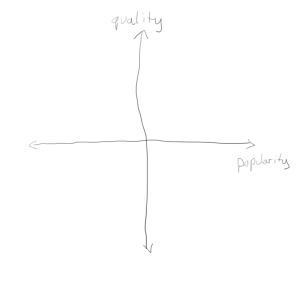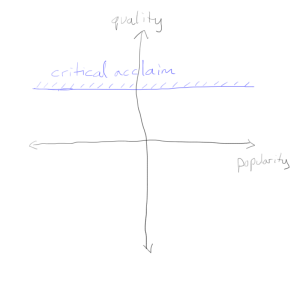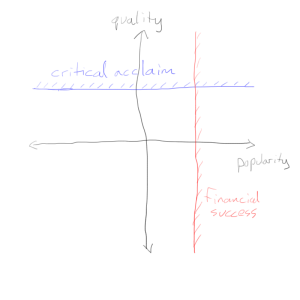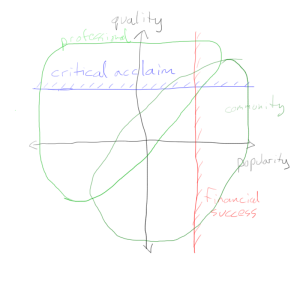Thanks in part, I’m sure, to craptastic weather conditions in Ottawa over the weekend, a spirited discussion of the nature of theatre, audiences, marketing, and economics erupted on Twitter early Saturday morning and continued well into Sunday (when we finally decided on the #OThChat hashtag to dispense with the immense block of @s and keep things “organized”). I hope it continues to continue.
The discussion touched briefly upon a fact which, although it seems self-evident, frustrates the hell out of people who make a living (or aim to) out of creating art: quality and popularity are independent quantities. In other words, just because it’s “good” doesn’t mean it will sell.
There is a fair amount of subjectivity involved in the assessment of quality, to start with. I’m of the opinion that aesthetic value, like any physical measurement or other perception, depends on the observer, that which is observed, and the act of observation. These things are variable. But there is such a thing as technique, and even if it cannot be objectively measured, some value can be established by consensus. We all agree, I hope, that an actor standing two feet to the left of his mark (and well out of his light) is bad quality—the craft is lacking.
Popularity, on the other hand, can be measured by attendance or box office revenue with a fair degree of accuracy. If a show sells out, it is popular; if there are blocks of empty seats, it is unpopular. It’s not that it rained or that there was no parking; unless you kept your show a secret, it’s unpopular, by definition. (Could it have been made popular? Very possibly. But that’s not what we’re talking about right now.)
Here’s where it falls apart: something can be very good, very well-done, yet be unpopular. This is less of a problem in the “durable” arts (the plastic arts, literature, recorded music—anything you can put in a box and save for later) than the performance arts, since tastes may change over the years and decades (unfortunately the creator often dies first).
We have evolved critics ostensibly to determine what is good, and ideally they will laud high-quality theatre. When the public doesn’t know any better—and they can’t, really, in advance—they must turn to the critic for an opinion with which to compare their own. The critic walks a tightwire strung between public opinion and the accepted (in some cases centuries-old) wisdom as to what determines quality in a given art form. Criticism is, in one sense, the art of thinking about art, and the art of articulating that thought. The role of the critic is, ideally, to attempt to rotate the “popularity” axis counterclockwise so that it more closely approximates the “quality” axis.
Since popular means that people showed up and (presumably, or what are you doing?) paid, it follows that popular productions are financial successes (hopefully, they made a profit). The definition of a financial success is an accounting question rather than an economic one, and it’s muddled somewhat by the issue of grants. You can always, however, peek out from the wings and see how many seats are full. Popularity, all other things being equal, can depend upon such factors as appropriateness for season (try producing an intellectually-charged tragedy in the middle of winter) or local relevance. It is rarely influenced by the rain.
Now here’s the diagram that’s going to piss everyone off (with any luck). These are the regions of the graph we might expect professional and community theatre to occupy.
Let me start by saying that I love community theatre. For one thing, it’s pretty much the only way, in a market like ours here in Ottawa, that we will see plays with a cast of more than four characters on stage. Also, perhaps also because of the state of the market, some of our community theatre is pretty good quality.
On the other hand, I also think that the people who produce/create a product should, if they so desire, be paid in accordance with the perceived exchange value (with society) of their contribution to the product. That means, if you consider that theatre has value (and why are you reading this if you don’t?), then actors (and crew, and everyone else involved with a production) deserve to be paid. Unless, of their own free will, they waive that pay.
Can community and professional theatre co-exist? Certainly. But there are certain conditions that must be met for that to happen.



